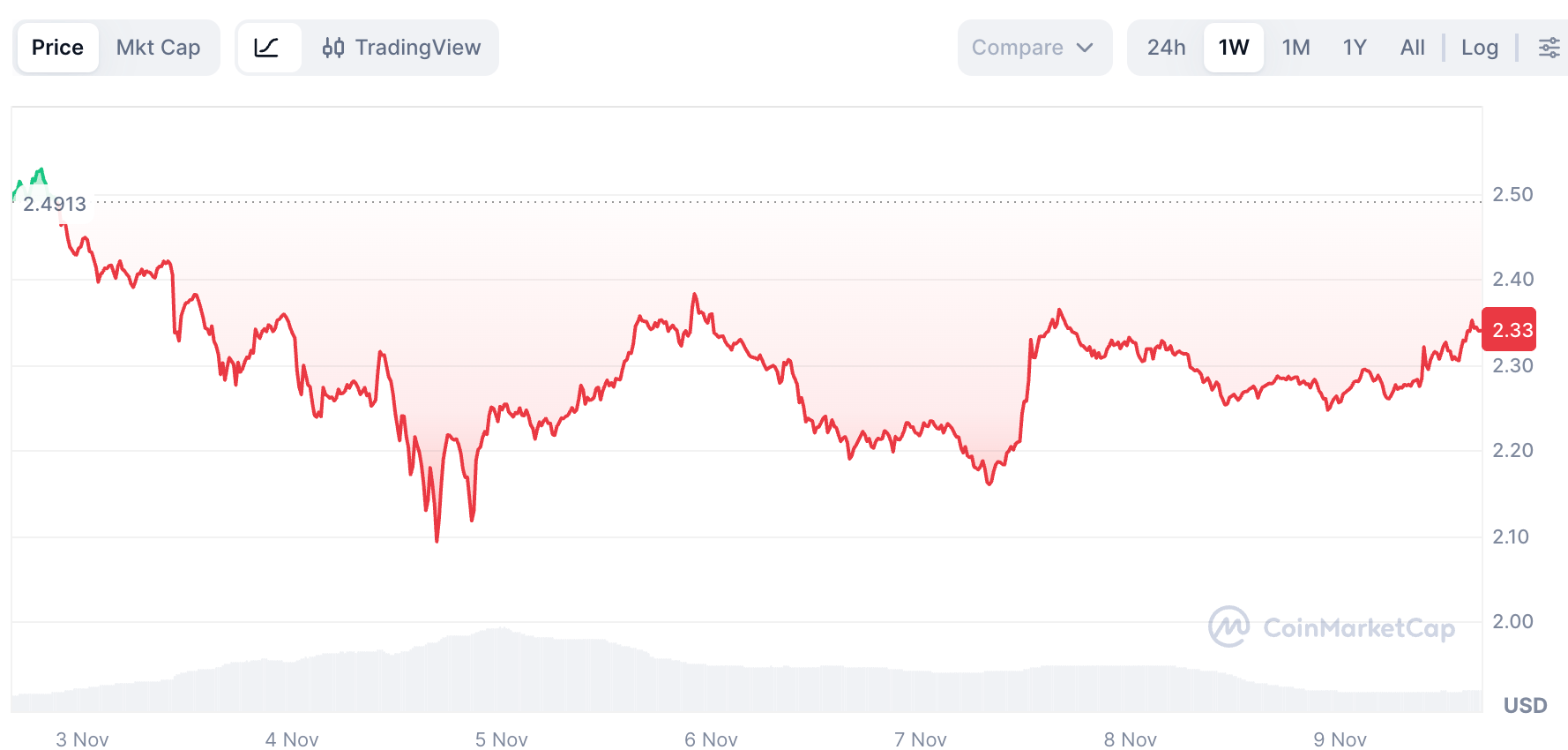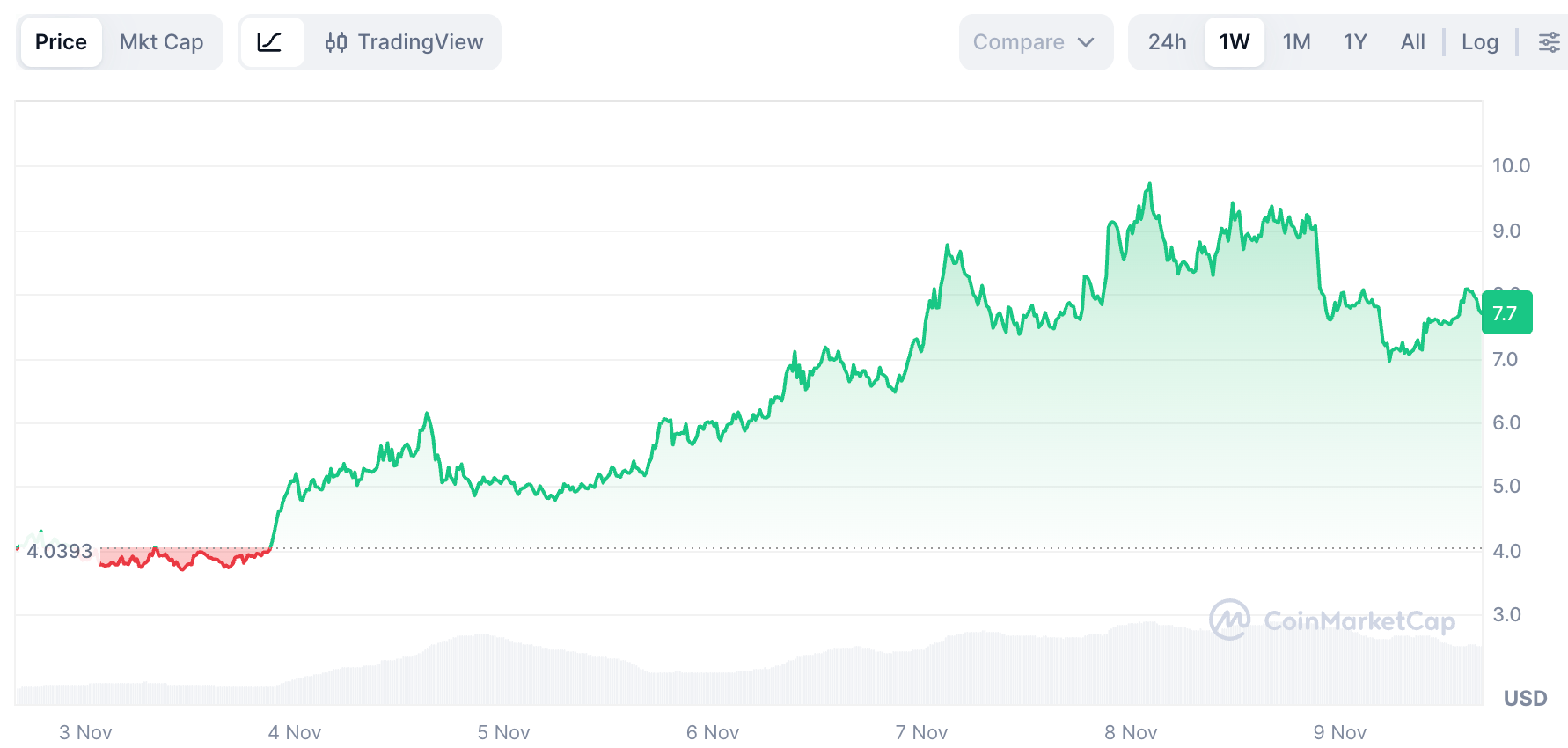- The Vester Pulse
- Posts
- Bitcoin Breaks Below $100K - What Happens Next?
Bitcoin Breaks Below $100K - What Happens Next?
Markets wobble, but smart money and smarter tools are already positioning for the rebound
Vester Updates
Nothing major to report from the Vester team this week. The focus remains on refining the user experience and further improving the precision and clarity of outputs.
We’re entering the final stages of beta, expect an official announcement soon as Vester transitions out and move toward full-scale launch.
Market Updates
Market Overview — November 9, 2025
| Segment | Current Value | Change (7d) |
|---|---|---|
| Global Market Cap | ||
| Total Crypto Market | ≈ $3.7 T | ↓ 2.9 % |
| Sector Performance (GMCI) | ||
| DeFi (GMCI DeFi Index) | 68.2 | ↑ 5.5 % |
| Layer-1 (GMCI L1 Index) | 176.1 | ↑ 3.0 % |
| Top Coins (Tracker) | ||
| Bitcoin (BTC) | ≈ $104,490 | ↓ 5.0 % |
| Ethereum (ETH) | ≈ $3,584 | ↓ 6.9 % |
| Solana (SOL) | ≈ $165.3 | ↓ 10.6 % |
| BNB (Binance Coin) | ≈ $998.11 | ↓ 7.6 % |
| XRP (Ripple) | ≈ $2.3 | ↓ 6.5 % |
Crypto markets pulled back this week, with total capitalization slipping to roughly $3.72 trillion, down about 2.9% from the previous week. The decline followed renewed risk-off sentiment and profit taking after a strong run-up, leaving most large-cap assets in the red despite still elevated volumes.
Bitcoin fell around 5.0% to about $104,490, while Ethereum dropped 6.9% to trade near $3,584. Solana was hit harder, losing roughly 10.6% to about $165 as traders rotated out of high-beta names. BNB declined 7.6% to just under $1,000, giving back part of its recent outperformance, and XRP slid 6.5% to roughly $2.33 after its sharp rally the prior week.
Sector indices also softened. The GMCI Layer-1 Index fell 7.0% to about 176, reflecting broad weakness across major smart contract platforms. The GMCI DeFi Index proved more resilient, easing only 1.7% to roughly 68, as on-chain lending and DEX activity held up better than the large-cap layer-1 complex.
Crypto News
CFTC Pushes for Leveraged Trading on Regulated Exchanges
The Commodity Futures Trading Commission (CFTC) is moving to bring leveraged spot crypto trading under its regulatory umbrella, a major structural shift that could reshape how digital assets are traded in the United States. Acting Chair Caroline D. Pham confirmed that the agency is working with designated contract markets (DCMs) to enable spot crypto products that include margin, leverage, and financing, potentially launching as early as next month.

The announcement signals an expansion of the CFTC’s oversight role. Historically limited to derivatives markets, the agency plans to use its existing authority under the Commodity Exchange Act to expand its oversight. This provision allows the CFTC to regulate leveraged, margined, or financed retail commodity transactions and enforce compliance without waiting for new legislation.
Market participants see the move as a step toward aligning crypto trading with traditional finance infrastructure, a development that could unlock significant institutional capital. By offering regulated access to leveraged spot products, U.S. exchanges could compete directly with offshore platforms that have long dominated this space.
Pham’s remarks also hint at growing cooperation between U.S. regulators and industry players, as the CFTC attempts to strike a balance between innovation and investor protection. The proposal aims to reduce systemic risk by bringing leverage trading into transparent, well-supervised environments while still preserving competitive market dynamics.
Supporters argue that a regulated framework could increase liquidity, tighten spreads, and attract professional traders who have previously avoided crypto due to compliance uncertainty. Critics warn, however, that introducing leverage into U.S. spot markets could heighten volatility and risk for retail participants, particularly without comprehensive cross-agency oversight between the CFTC and the SEC.
TRILLIONS Token Spike After Tesla News
A newly minted memecoin called TRILLIONS exploded in value after Tesla shareholders approved a compensation package for Elon Musk reportedly worth up to one trillion dollars. The token appeared within hours of the news breaking and immediately gained traction across Solana and Ethereum. In less than 24 hours, TRILLIONS surged by almost 200 percent, with trading volume climbing past 20 million dollars. Social media posts linked the rally to Musk’s pay package, framing the coin as a “tribute” to what would be one of the largest compensation deals in corporate history.

Trading activity around the token was highly concentrated on decentralized exchanges, where liquidity pools were shallow and prices fluctuated rapidly. On Solana, several versions of TRILLIONS were launched simultaneously, creating confusion among traders about which contract was legitimate.
Within a day, some pools were drained by their creators, suggesting that parts of the surge may have involved coordinated pump-and-dump behavior. By the second trading day, prices had retraced sharply from their highs, wiping out a large share of paper gains and leaving late buyers with losses.
High-profile news involving Musk often serves as a catalyst for sudden token creation, and this event showed how rapidly capital can flow into and out of these narratives. The spike underscored the fragility of tokens without established liquidity or credible teams behind them. While a handful of traders profited from early entries, most participants were exposed to extreme volatility and exit risk.
The TRILLIONS token surge captures the intersection of cultural headlines and speculative trading. It reflects how the market continues to blur the lines between entertainment and finance, rewarding speed and timing over fundamentals.
European law enforcement agencies have taken down a massive crypto fraud and money-laundering network responsible for stealing approximately 689 million dollars from investors across multiple countries.
The coordinated operation involved authorities from France, Belgium, Spain, Germany, and Cyprus, marking one of the largest international crackdowns on cryptocurrency-related financial crime to date. Nine individuals were arrested during raids conducted in late October after a multi-year investigation led by Europol.

The criminal organization operated dozens of fake investment platforms that promised high returns through cryptocurrency trading and staking. Victims were lured in through social media advertisements and aggressive cold-calling campaigns, with funds then funneled through a web of offshore accounts and blockchain mixers to obscure their origin. Investigators uncovered evidence of extensive layering and conversion into stablecoins and privacy-focused cryptocurrencies, which were later laundered through shell companies and peer-to-peer exchanges.
Authorities seized close to one million dollars in bank accounts and nearly half a million dollars in cryptocurrency. They also recovered more than 300,000 dollars in cash along with several luxury assets, including high-end watches and vehicles. The defendants face charges of organized fraud, money laundering, and providing unlicensed investment services. Under French law, they could face up to ten years in prison and fines exceeding one million euros if convicted.
The case highlights Europe’s growing focus on crypto-related financial crime ahead of the full implementation of the Markets in Crypto-Assets (MiCA) framework. Officials stated that the operation demonstrates the EU’s increasing ability to coordinate cross-border enforcement in complex financial investigations involving digital assets. For regulators and investors, the crackdown underscores that fraud schemes are still prevalent in loosely regulated corners of the crypto market, even as oversight tightens.
Ripple Expands Institutional Footprint
Ripple has entered a new growth phase after raising $500 million in a strategic funding round led by Citadel Securities and Fortress Investment Group, valuing the company at roughly $40 billion. The announcement coincided with a short-term jump in XRP’s price and trading volume as investors reacted to Ripple’s expanding institutional ambitions.

The funding will accelerate Ripple’s expansion beyond payments and into broader institutional infrastructure for digital assets. As part of this strategy, Ripple also acquired Palisade, a custody and wallet technology provider specializing in secure, multi-chain institutional storage solutions. The acquisition adds an important layer to Ripple’s product stack. It allows banks, fintechs, and corporates to securely hold and transact digital assets through Ripple’s existing network.
The company’s leadership emphasized that this phase represents a pivot toward long-term adoption rather than speculative growth. Ripple’s network is anchored by the XRP Ledger, which serves as the foundation for its expanding ecosystem. It continues to attract interest for real-world use cases such as tokenization, on-chain settlements, and cross-border liquidity management.
These capabilities, combined with Palisade’s technology, position Ripple to compete directly with established institutional custodians and bridge the gap between traditional finance and digital assets.
Token of the Week
Internet Computer (ICP) had a strong week as developers and investors responded positively to new network upgrades that expand its on-chain AI capabilities. The token climbed dramatically over the past seven days (90%), supported by rising transaction activity and renewed institutional attention toward decentralized compute infrastructure.

The Internet Computer network, built by the DFINITY Foundation, aims to extend the functionality of the internet by hosting smart contracts and decentralized applications directly on-chain without relying on traditional cloud providers.
This week’s upgrade introduced support for native AI model integration, enabling developers to deploy inference APIs and AI-driven logic directly on the blockchain. The move positions ICP as one of the few layer-1 networks focused on merging compute, storage, and intelligence into a unified, decentralized environment.
ICP’s recent price movement reflects growing interest in networks that bridge blockchain and artificial intelligence. The upgrade improves developer tools and reduces computational latency, making it easier for projects to build scalable, data-rich applications. Analysts noted that this shift toward AI-native functionality could differentiate ICP from other smart contract platforms like Ethereum and Solana, particularly for enterprises exploring decentralized data processing.
For now, the network’s fundamentals appear stronger than in previous quarters, with rising active canister counts (the on-chain equivalent of smart contracts) and expanding ecosystem activity.